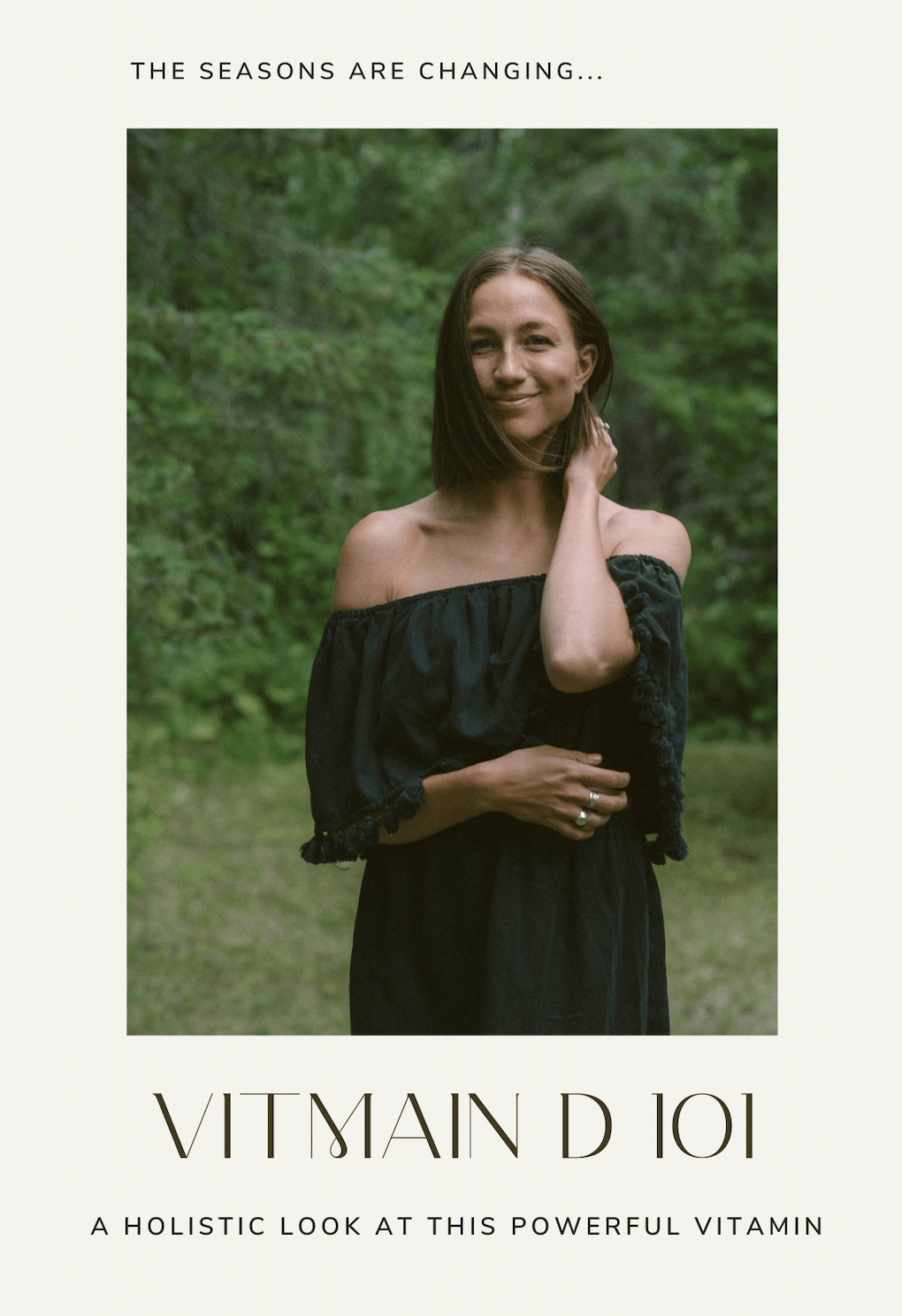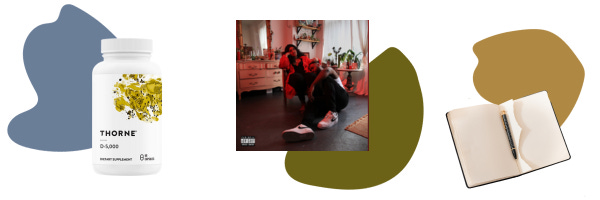As the weather turns colder and the days get shorter, it’s the perfect time to have a chat about one particular vitamin that can truly do so. much. for your overall health…
And that is Vitamin D!
So today we are doing a vitamin-Deep dive (that’s my only bad joke of the post, I promise!) on this powerhouse nutrient.
You’re likely familiar with vitamin D, you might know the basics, you’ve heard it’s good for you — but we’re getting into the nitty gritty & breaking down just WHY it’s so important, what it does in the body, why so many of us are deficient, and how you can improve your levels.
As always, just a brief disclaimer that nothing I share on The Reset constitutes medical advice. I encourage you to work with *your* personal provider when it comes to making any changes to your healthcare plan ◡̈ Every body is different & it’s important to get individual guidance.
And with that being said, let’s jump in!
So you may know vitamin D’s more well-known benefits: it’s good for bone health, it supports mood, etc., but in reality it goes far beyond that.
In fact, Vitamin D (also referred to as "calciferol") is actually less like a vitamin and more like a hormone.
Big picture: this ain’t your average vitamin — it plays so many roles in the body. Such as…
Immune health. We all know that vitamin C is important for immune health, but did you know vitamin D is crucial too? Studies have shown that people with adequate vitamin D levels are significantly less likely to get respiratory infections. In fact, concentrations of 38 ng/ml or more of Vitamin D were associated with a two-fold reduction in developing respiratory illness and a significant reduction in days ill. (This is CLUTCH as we enter cold & flu season.)
Less school illnesses: Let me guess, your kiddos are constantly coming home from school & daycare sick? A randomized, double-blind, placebo-controlled trial showed that schoolage children who were supplemented with Vitamin D were significantly less likely to get the flu (and even a reduction in asthma attacks). Another immune win!
Neuro-protective properties. It can help your mental health! Observational studies show an association between low levels of vitamin D and depression. While there is still conversation on if this is causal or correlational, Vitamin D receptors are present in areas of the brain thought to be involved in the pathophysiology of depression.
Musculoskeletal Health. Vitamin D is plays an important role in both bone & muscle health. Research has shown that inadequate vitamin D intake can lead to bone demineralization (due to the relationship between vitamin D and calcium) and eventually weakened muscles. Because of this, Vitamin influences fracture-risk via a variety of different mechanisms.
Auto-immune Diseases: There have been correlations of low-vitamin D levels and various auto-immune disorders, such as MS. For example, there seems to a geographical component to MS prevalence which seems to correlate with inadequate Vitamin D levels— where women with Vit D levels of less than 30 had a 43% higher MS risk than women with levels of 50 or higher. However, while low levels of vitamin D are not necessarily the underlying cause of the autoimmune disease, it is thought that low levels of vitamin D can make autoimmune disease states worsen.
Lower all-cause mortality (yes, really): A 2014 systematic review of 32 studies reported that low vitamin D levels (below 30) was significantly associated with higher all-cause mortality. Another comprehensive review of 73 cohort studies (over 88,000 participants included) found that supplementation with vitamin D3 significantly reduced overall mortality among older adults.
Why is this? While data is always emerging and shifting, some experts believe that Vitamin D plays a crucial role in at least 1,000 (!) different genes, therefore having a subsequent impact on nearly every tissue in the body— from your thryroid, to your cognitive function, to even your pregnancy, Vitamin D has a powerful impact on many different aspects of your body.
TL;DR: from immune function to bone health to mood — vitamin D truly is *that girl*
So, we know Vitamin D is important. What’s the big deal about it?
Well….The Cleveland Clinic estimates over 50% of Americans to have insufficient levels of Vitamin D. (Yes, really.)
It’s common to be deficient in this important vitamin, and there’s many [valid!] reasons for this—
One is because it isn’t naturally found in that many foods. So even if you’re eating a varied diet with tons of vegetables, adequate protein, and well-sourced ingredients, you might still be deficient in vitamin D.
Another factor here is that vitamin D is largely gained through sun exposure, so levels of this vitamin vary greatly based on where you live. If you’re in, say, San Diego where the sun is out frequently and the weather is nice all year, 1) can I visit? And 2) getting adequate vitamin D may be less of an issue for you.
However, if you’re somewhere like New York, Minnesota, or the misty Pacific Northwest, even if you’re outside a lot you may be deficient in vitamin D because you’re not getting consistent sun exposure year-round.
Other groups more likely to be vitamin D deficient include:
Older adults because our skin’s ability to absorb vitamin D declines with age & the elderly may naturally spend more time indoors.
People with limited sun exposure: including those who live in less sunny places and/or those who often avoid or cover up from the sun
People with darker skin: because greater amounts of melanin can reduce the skin’s ability to produce vitamin D from sunlight
People with conditions that limit fat absorption, because vitamin D is fat soluble so its absorption depends on the gut’s ability to absorb dietary fat
People who have had GI/gastric bypass surgeries: because vitamin D is fat soluble and its absorption occurs in the small intestine, which is partially bypassed as a result of the surgery
…but really, anyone can be vitamin D deficient, and it’s VERY common.
There are three main, simple ways to increase your vitamin D: sun, supplements, and food.
Sunlight is huge when it comes to vitamin D levels!
It has been shown that 30 minutes in the summer sun in a bathing suit can initiate the release of about 50,000 IU vitamin D into circulation within 24 hours of exposure for most white people; 20,000–30,000 IU in tanned individuals and 8,000–10,000 IU in dark-skinned people. Wow! So much Vitamin D bang-for-your-buck.
And while I am all about being cautious of skin cancer, skin damage, sun screen etc. it is good to spend some SMART time out in the sun (it is possible!) In fact, I have a whole post about smart + intentional sun exposure (one of my most popular ever!).
But again, depending on where you live, regular sun exposure may not be possible as a reliable way to boost your levels (speaking as someone who lives in Northern Minnesota… *nervous laugh*).
And in that case it’s recommended that you may need to supplement vitamin D.
what should my Vitamin D levels be?!
Now I do want to mention that the only way to know if you’re deficient is to get a formal lab test, in which most doctors will tell you that the “normal” range is 30-100 ng/mL. And this is fine! There’s a lot of merit to this, and it is well… normal.
But, remember, there can often be a difference between “normal” lab values and “optimal” lab values ;)
Personally, I would prefer to see people above 30 ng/mL and more in the 50-75 range.
I mention that because even if you aren’t technically deficient (say if your level is 31 or something), there may be some value in increasing your vitamin D levels slightly as it is so impactful for mental health, bone health, and immune health.
how should I supplement?
As far as the supplements themselves, a lot that you’ll find on the shelf are around 500-800 IU per day. While this dose is totally appropriate and fine for most people, it can often be too small of a dose depending on where you live, your current Vitamin D levels, your age, body size, etc.
For many people, 1,000-5,000 IU may be more impactful (some providers even prescribe 10,000IU or more aggressive bolus doses). I personally stay “in the middle” of these two extremes and take 1,000 IU in the spring/fall and up to 5,000 IU in the winter, but again this is something I’ve talked about with my doctor.
So I’m not saying you should do this (because, as with anything, there can be “too much” of a good thing & everyone’s needs are unique), but just note the typical dosing of Vitamin D may need to be increased, especially for those of us who live in cold climates without a ton of sunlight.
What foods have vitamin D?
So, the good news— there ARE real food sources that have vitamin D!
…but they are quite particular & not super easy to consume (what, you’re not eating fish liver every day?!).
Fatty fish like salmon, trout, tuna and mackerel
Canned fish like herring and sardines
Egg yolks
Mushrooms
Cod liver oil
Beef liver
Fish liver
While these are good sources of Vitamin D, you may need to eat a large portion to really get an adequate dose.
So while it doesn’t hurt, I typically don’t recommend food sources as the best place to boost your levels if you’re deficient— it can be much more efficient to get vitamin D from sunlight and supplements, but feel free to introduce some of these foods into your diet! ◡̈
The reason I wanted to really dig into this today is because we are full-steam ahead going into fall & winter – a.k.a. the darkest time of the year where illnesses galore & seasonal depression abound.
Naturally our vitamin D levels may lower during this time which can subsequently impact things like immune function and mood changes.
If there was a time to start supplementing – it would be now!
While I will never claim that Vitamin D (or anything for that matter) is a “cure-all” , you can see it’s incredibly important for many different reasons.
So, if you think you may need a lil extra boost this time of year, I’d recommend trying to get some smart daily sunshine and if that’s not possible then consulting with your healthcare provider to discuss a lab test & supplementation.
This can be an easy way to support your health (both mental and physical!) during these cold, dreary months. Sending some extra light to you this season.
Cheers, friends!
(Psssst: was this post helpful? If so, drop me a “heart” or a comment below! This is helpful way for me to see which types of posts are resonating for you all!)
PRODUCT OF THE WEEK: Just in case you were curious— this is the Vitamin D supplement that *I* personally take. As always, I would chat with your doctor to find the dosage that they recommend for you!
SONG OF THE WEEK: This came on my “recommended for you” spotify shuffle, and what a VIBE. Easy listening, but has a fun, sexy beat. “Breakfast in Bed” by Rayana Jay— find it here!
JOURNAL PROMPT OF THE WEEK: “How am I feeling about fall & winter this year? What emotions am I noticing as the seasons change?”
IN CASE YOU MISSED IT…




















Hey Kate, I loved this post! I wanted to ask about liquid vitamin D options. I’ve heard from a few medical professionals that our body absorbs the liquid supplements better than pill supplements but the cost difference in the two options is big so I have avoided switching! Have you read studies around this or have any insight?
Love this breakdown, Kate!! I started becoming more conscious of my Vitamin D levels when I experienced SAD while living in DC. Now that I’m in a much sunnier climate (NC), I take some of my husbands gummy supplements every now and again (which his doctor recommended!) Feel like it might be finally time to get my own. 😂